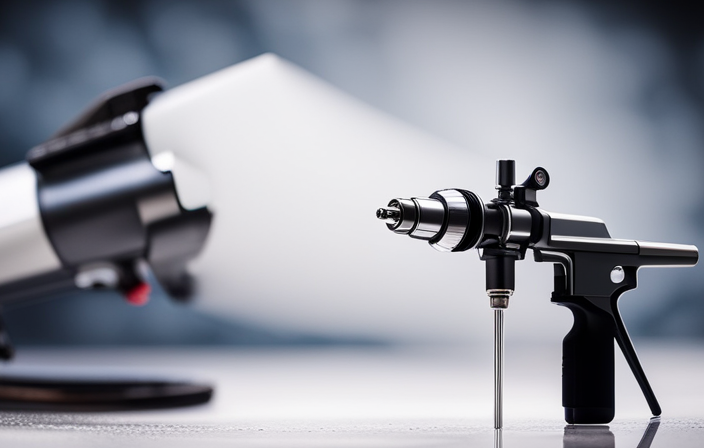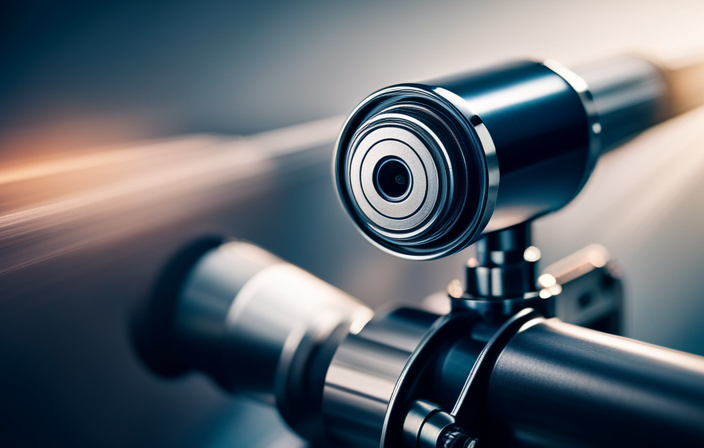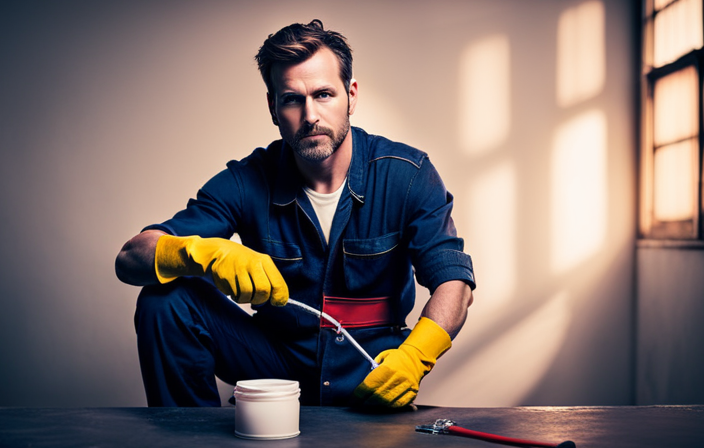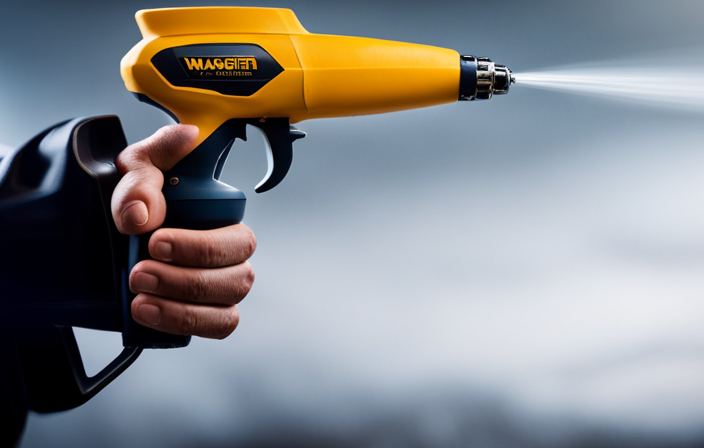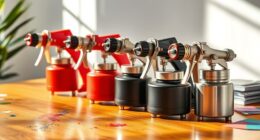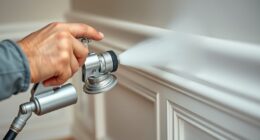Did you know that air bubbles may appear when using an airless paint sprayer? This common issue can affect the overall quality of your painting project.
In this article, I will delve into the various factors that can cause these air bubbles to form and provide you with practical solutions to prevent them.
First and foremost, proper equipment setup and maintenance are crucial. Ensuring that your sprayer is clean and in good working condition will help minimize the chances of air bubbles appearing.
Additionally, the viscosity of your paint plays a significant role. If the paint is too thick or too thin, it can lead to air entrapment during the spraying process.
Furthermore, air pressure issues and paint preparation techniques can also contribute to the formation of air bubbles. By understanding the impact of spray technique, paint quality, surface preparation, and sprayer tip issues, you’ll be equipped with the knowledge to troubleshoot and solve any problems that arise.
So, let’s dive in and explore the causes of air bubbles when using an airless paint sprayer, allowing you to achieve a flawless finish every time.
Key Takeaways
- Premium paint with consistent formulation reduces air bubble likelihood.
- Proper surface preparation, including cleaning and smoothing, minimizes air bubbles.
- Clean and unclog the sprayer tip before using to prevent air bubbles.
- Follow manufacturer’s instructions for paint thinning and regularly clean the sprayer to avoid air bubbles.
Equipment Setup and Maintenance
Make sure you take good care of your equipment and follow proper maintenance procedures to prevent any frustrating air bubbles from ruining your paint job!
Sprayer maintenance is crucial in ensuring smooth and flawless paint application. Start by cleaning the sprayer thoroughly after each use, removing any paint residue or debris that could clog the nozzle or cause air bubbles.
Regularly inspect the sprayer for any worn-out or damaged parts, such as seals or gaskets, and replace them promptly. Additionally, make sure to follow the manufacturer’s instructions for lubrication and storage.
If you encounter air bubbles despite proper maintenance, try troubleshooting tips such as adjusting the pressure settings, checking the paint consistency, or using a different type of paint.
By giving your equipment the care it deserves, you can minimize the chances of air bubbles and achieve professional-looking results.
Now, let’s move on to the next section about paint viscosity.
Paint Viscosity
The thicker the paint, the more likely it is to create a bumpy texture when applied with an airless sprayer. This is because the paint application becomes uneven and the excess thickness can lead to air bubbles forming. When the paint is too thick, it doesn’t flow smoothly through the sprayer nozzle, causing the paint to dry unevenly and leaving behind a textured surface.
To prevent this issue, it’s important to check the paint viscosity and adjust it accordingly by adding a suitable thinner or water to achieve the desired consistency. By ensuring the paint is the right viscosity, you can minimize the formation of air bubbles and achieve a smooth finish.
Now, let’s move on to discussing air pressure issues and how they can affect the paint application process.
Air Pressure Issues
Ensure you adjust the air pressure correctly to achieve a smooth and even application when using an airless sprayer. The air pressure plays a crucial role in preventing air bubbles from forming in your paint. If the pressure is too high, it can cause the paint to atomize excessively, leading to the formation of air bubbles. On the other hand, if the pressure is too low, the paint may not atomize properly, resulting in an uneven application. To find the optimal air pressure, refer to the manufacturer’s guidelines or conduct a test spray on a scrap surface. Additionally, make sure the air compressor supplying the sprayer is in good working condition and capable of maintaining a consistent pressure. By properly adjusting the air pressure and ensuring the paint consistency is appropriate, you can minimize the likelihood of air bubbles forming during your paint job. This will create a solid foundation for the subsequent section on paint preparation.
Paint Preparation
Start by thoroughly cleaning and sanding the surface you plan to paint, as this will help the new paint adhere properly. Paint adhesion is crucial in preventing air bubbles from forming when using an airless paint sprayer. Make sure to remove any dirt, dust, or grease that could interfere with the paint’s ability to bond with the surface.
Once the surface is clean, allow it to dry completely before applying the paint. This is important because if the surface is still wet, the paint may not adhere properly, leading to air bubbles. Additionally, pay attention to the recommended drying time of the paint you’re using. Applying another coat before it’s fully dry can also cause air bubbles to form.
By properly preparing the surface and allowing sufficient drying time, you can minimize the risk of air bubbles.
Moving on to the next section about the ‘spray technique,’ it’s important to maintain a consistent distance and speed while spraying to achieve a smooth finish.
Spray Technique
When it comes to achieving a flawless paint finish with an airless paint sprayer, maintaining a consistent distance from the surface is crucial. This ensures that the paint is applied evenly and prevents any streaks or uneven coverage.
Additionally, using smooth and even strokes while applying the paint helps to create a seamless and professional-looking result. By following these techniques, you can achieve a smooth and flawless paint finish with your airless paint sprayer.
Maintain a consistent distance from the surface being painted
To prevent air bubbles from forming when using an airless paint sprayer, how can we maintain a consistent distance from the surface being painted? Maintaining a consistent distance is crucial to ensure a smooth and bubble-free paint job. By following a consistent spray technique and selecting the proper nozzle, you can achieve optimal results. Here’s a helpful table to guide you:
| Distance from Surface | Spray Technique |
|---|---|
| 12-16 inches | Horizontal strokes |
| 8-12 inches | Vertical strokes |
| 6-8 inches | Diagonal strokes |
By keeping the nozzle at the recommended distance and utilizing the appropriate spray technique, you can minimize the chances of air bubbles forming. Remember to use smooth and even strokes to apply the paint, as this will help create a flawless finish. With these tips in mind, you can achieve professional-looking results with your airless paint sprayer.
Use smooth and even strokes to apply the paint
Using smooth and even strokes while applying the paint will create a flawless finish that will leave you feeling accomplished and proud of your painting job. It’s important to maintain a consistent distance from the surface being painted and to move the sprayer in a steady, controlled motion. This helps ensure a smooth application and even coverage of the paint.
By applying the paint in this manner, you reduce the chances of air bubbles forming. Uneven strokes or jerky movements can cause the paint to be applied unevenly, leading to air bubbles forming on the surface. Therefore, it’s crucial to take your time and apply the paint with smooth and even strokes.
Transitioning into the subsequent section about ‘ambient conditions’, it’s also important to consider the environment in which you’re painting.
Ambient Conditions
In order to minimize air bubbles, you should pay close attention to the ambient conditions. Humidity control is crucial when using an airless paint sprayer. High humidity levels can cause moisture to mix with the paint, leading to the formation of air bubbles.
It is important to work in a controlled environment with low humidity levels to ensure a smooth paint application. Additionally, temperature effects should be taken into consideration. Extreme temperatures, whether too hot or too cold, can affect the viscosity of the paint and lead to the formation of air bubbles.
Maintaining an optimal temperature range is essential for achieving a bubble-free finish. By controlling both humidity and temperature, you can greatly reduce the occurrence of air bubbles in your paint application.
Transitioning into the subsequent section about ‘paint quality’, it’s also important to consider the role of the paint itself in preventing air bubbles.
Paint Quality
Premium paint products provide a polished and pristine finish, preventing pesky pockets of trapped air. When it comes to airless paint sprayers, the quality of the paint being used plays a crucial role in minimizing air bubbles. Here are three reasons why paint quality matters:
-
Paint Adhesion: High-quality paint adheres better to surfaces, resulting in a smoother application. This reduces the chances of air bubbles forming during the spraying process.
-
Paint Drying Time: Premium paints often have shorter drying times, allowing them to settle and level out before air bubbles can form. This is especially important when using an airless paint sprayer, as the fast-drying paint reduces the risk of trapped air.
-
Consistency: Top-notch paint products have a consistent formulation, ensuring even distribution and reducing the likelihood of air bubbles.
Proper surface preparation is crucial to achieve a flawless finish. By taking the time to prepare the surface adequately, you can further minimize the potential for air bubbles in your paint job.
Surface Preparation
Before applying paint, it’s crucial to properly prepare the surface. Cleaning and smoothing the surface ensures optimal adhesion and a flawless finish.
Additionally, filling in any cracks or imperfections helps prevent air pockets from forming, resulting in a smoother paint application.
Clean and smooth the surface before painting
Make sure to thoroughly prep the surface to achieve a flawlessly painted finish. Proper surface preparation is crucial in preventing air bubbles when using an airless paint sprayer. Start by cleaning the surface using effective cleaning techniques, such as washing with soap and water or using a mild detergent.
Remove any dirt, grease, or loose particles that may interfere with the adhesion of the paint. After cleaning, it’s important to prime the surface before painting. Priming helps to seal the surface and provides a smooth and even base for the paint.
Once the surface is clean and primed, it’s time to fill in any cracks or imperfections to prevent air pockets. By addressing these issues beforehand, you can ensure a smooth and bubble-free painting experience.
Fill in any cracks or imperfections to prevent air pockets
To achieve a flawlessly painted finish, it’s essential to fill in any cracks or imperfections on the surface, ensuring a smooth and bubble-free result. Here are four important steps to follow when it comes to crack filling and preventing air pockets:
-
Inspect the surface thoroughly: Before starting the crack filling process, carefully examine the surface for any cracks, holes, or imperfections. This will help you identify areas that require attention and ensure a thorough repair.
-
Clean and prepare the area: Clean the surface using a mild detergent and water to remove any dirt, dust, or debris. Ensure the area is dry before proceeding with the crack filling process.
-
Choose the right filler: Select an appropriate filler that matches the material of the surface you’re working on. Different fillers are available for various surfaces, such as wood, drywall, or concrete.
-
Apply the filler and smooth it out: Using a putty knife, apply the filler into the cracks or imperfections, ensuring it’s level with the surface. Smooth out the filler to create a seamless finish.
By following these steps, you can effectively fill in cracks and imperfections, preventing air pockets and achieving a flawless paint job.
Moving on to sprayer tip issues, make sure you address any potential problems with the sprayer tip to further avoid air bubbles.
Sprayer Tip Issues
One common issue with sprayer tips is that they can cause air bubbles to form when using an airless paint sprayer. This happens when the sprayer tip becomes clogged or blocked, preventing the paint from flowing smoothly.
Sprayer clogging can occur due to various reasons, such as using paint that’s too thick or contains debris, or when the nozzle becomes partially or completely blocked. When the sprayer tip isn’t functioning properly, it can disrupt the paint flow, leading to the formation of air bubbles. These bubbles then get mixed with the paint and create an uneven finish on the surface being painted.
To troubleshoot and solve this issue, it’s important to clean the sprayer tip thoroughly and ensure that it’s free from any blockages or debris before using the paint sprayer again. This will help prevent the formation of air bubbles and ensure a smooth and flawless paint application.
Troubleshooting and Problem-solving
When troubleshooting and problem-solving issues with an airless paint sprayer, it’s important to identify and address any issues as they arise.
This includes checking for any clogs or blockages in the sprayer tip, as well as ensuring that the paint is properly mixed and thinned.
If the issue persists or if you’re unsure how to resolve it, it’s always a good idea to seek professional advice or assistance. They can provide expert guidance and help you avoid any further complications.
Identify and address any issues as they arise
As issues arise, it’s important to promptly identify and address them in order to prevent air bubbles from forming when using an airless paint sprayer. To do this, it is crucial to identify the common causes of air bubbles and take preventive measures. Some common causes include improper thinning of paint, incorrect nozzle size, and excessive spraying speed. To address these issues, ensure that the paint is properly thinned according to the manufacturer’s instructions, use the appropriate nozzle size for the type of paint being used, and maintain a consistent spraying speed. Additionally, it is important to regularly clean the sprayer and inspect the paint for any impurities or contaminants. By following these steps, you can minimize the risk of air bubbles forming. However, if you encounter persistent issues, it is advisable to seek professional advice or assistance.
| Cause of Air Bubbles | Preventive Measures |
|---|---|
| Improper thinning of paint | Follow manufacturer’s instructions for thinning paint |
| Incorrect nozzle size | Use the appropriate nozzle size for the paint being used |
| Excessive spraying speed | Maintain a consistent and controlled spraying speed |
| Contaminated paint | Regularly clean the sprayer and inspect the paint for impurities |
| Inadequate cleaning of sprayer | Thoroughly clean the sprayer after each use |
In the event that these preventive measures do not resolve the issue, seeking professional advice or assistance may be necessary to ensure optimal performance and avoid further complications.
Seek professional advice or assistance if needed
When it comes to using an airless paint sprayer, it’s important to address any issues that may arise during the process. However, there may be instances where the problem is beyond our expertise.
In such cases, seeking professional advice or assistance is crucial. Professional guidance can provide valuable insights and solutions to tackle the problem effectively. They have the knowledge and experience to identify the root cause of air bubbles forming and can offer specific recommendations to prevent them.
Additionally, they can provide DIY tips and techniques to minimize the occurrence of air bubbles in the future. Remember, it’s always better to seek help from experts when needed, as it can save time, effort, and ensure a flawless finish to your paint job.
Frequently Asked Questions
Can air bubbles form while using an airless paint sprayer even if the equipment is properly set up and maintained?
Yes, air bubbles can still form with a properly set up and maintained airless paint sprayer. Common mistakes like using old paint or spraying too quickly can cause bubbles. Troubleshooting tips include thinning the paint and adjusting the pressure.
How does the viscosity of the paint affect the formation of air bubbles when using an airless paint sprayer?
The viscosity of the paint plays a crucial role in the formation of air bubbles when using an airless paint sprayer. Higher viscosity paints, or those with lower-quality ingredients, are more prone to trapping air and creating bubbles during the spraying process.
Are there any air pressure issues that can contribute to the formation of air bubbles when using an airless paint sprayer?
Air pressure issues can contribute to air bubbles in an airless paint sprayer. To prevent this, ensure the sprayer’s pressure is set correctly, check for clogs or leaks, and use the appropriate paint viscosity. Proper troubleshooting is key to avoiding air bubbles.
Does the quality of the paint used have any impact on the occurrence of air bubbles when using an airless paint sprayer?
Yes, the consistency of the paint used can impact the performance of an airless paint sprayer. To prevent air bubbles, it is important to use paint that is properly mixed and has the right viscosity.
Can improper surface preparation lead to the formation of air bubbles when using an airless paint sprayer?
Improper technique, like rushing the surface preparation, can lead to air bubbles when using an airless paint sprayer. Additionally, environmental factors, such as high humidity or fluctuating temperatures, can also contribute to their formation.
Conclusion
In conclusion, air bubbles can form when using an airless paint sprayer due to various factors. These factors include equipment setup and maintenance, paint viscosity, air pressure issues, paint preparation, spray technique, paint quality, surface preparation, and sprayer tip issues.
To avoid these bubbles, it’s important to ensure that the equipment is properly set up and maintained, the paint viscosity is suitable for the sprayer, and the air pressure is adjusted correctly. Additionally, proper paint preparation, spray technique, and surface preparation are essential for achieving a smooth and bubble-free finish.
Remember, just like a skilled conductor leading an orchestra to create a harmonious symphony, attention to detail and understanding the nuances of the painting process can help achieve flawless results.

